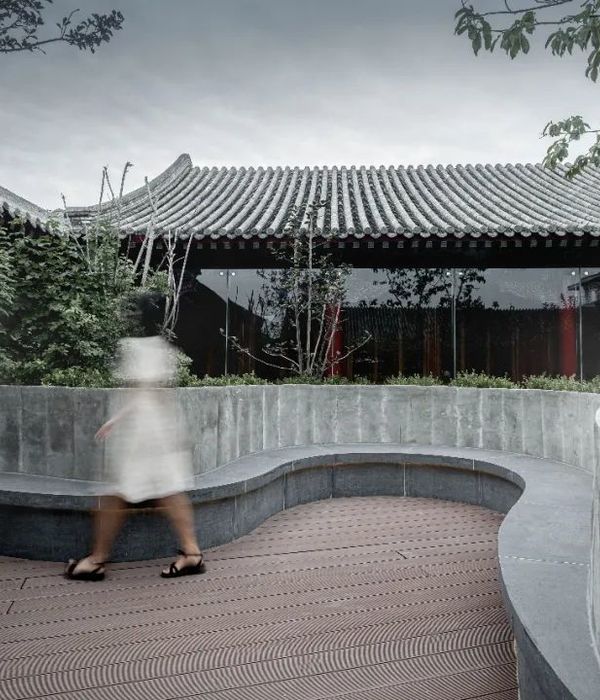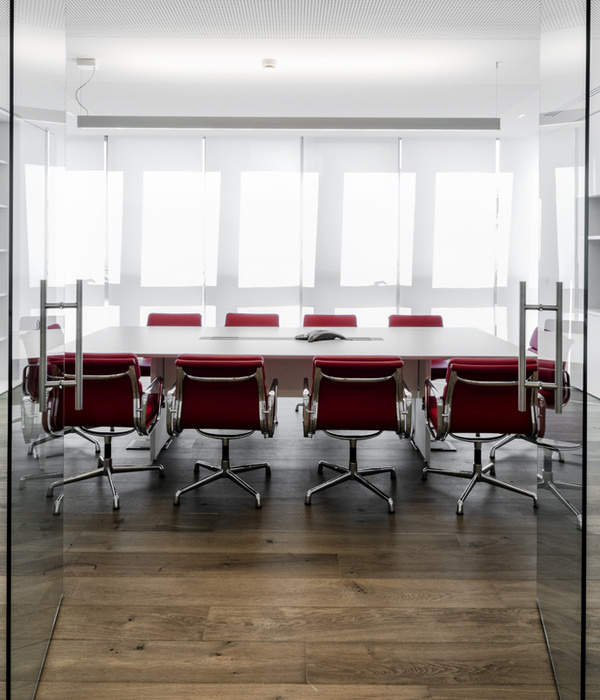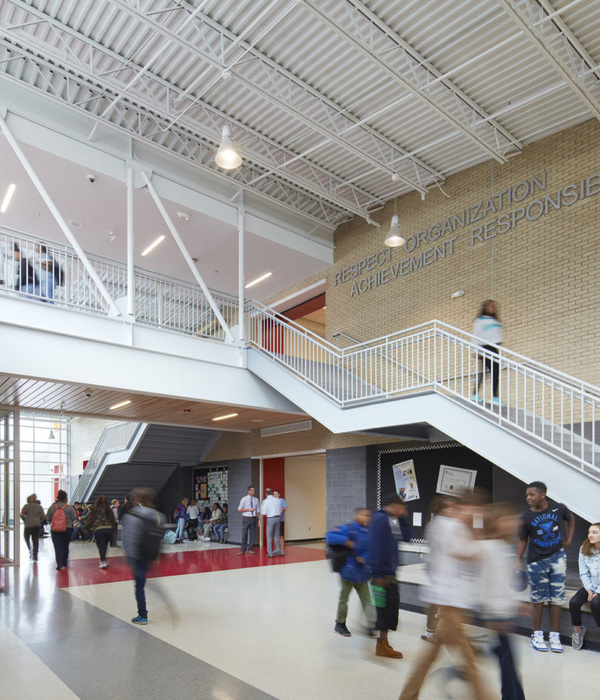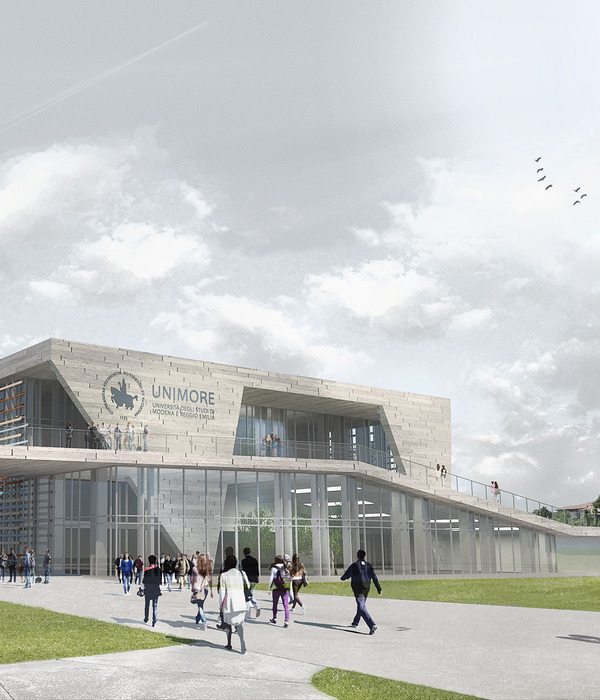▼体量生成分析,Volume generation analysis © 深圳华汇设计
▼建筑结构,Building structure © 深圳华汇设计
▼建筑年代,Built year © 深圳华汇设计
▼场地航拍,Site aerial view
二、思考与对策 Consideration and Countermeasure
1.十字轴——时间轴与空间轴 Cross axis——Time axis and Space axis
上位规划中已拆除其场地东北部分车间,并将其用做幼儿园用地。由于剩余厂房的开间及进深尺度较大,所以采取植入十字轴的策略,把L型厂房分解成四个相对独立但又互相搭接的体量,这样可以有效减少大开间、大进深空间,提升内部空间可达性。
▼体量生成分析,Volume generation analysis © 深圳华汇设计
▼建筑结构,Building structure © 深圳华汇设计
▼建筑年代,Built year © 深圳华汇设计
In the upper planning, the northeast part of the factory has been demolished and used as the kindergarten land. Due to the large size of the bay and depth of the remaining factory, the strategy of implanting a cross axis is adopted to decompose the L-shaped factory into four relatively independent but overlapping volumes, which can effectively reduce the large bays and depths to improve the accessibility of internal space.
▼改造后的鸟瞰图,Aerial view © 张超
2)尺度转换:天拖厂房是牛腿加排架式的结构体系且开间及进深尺度较大,因此我们尝试重新界定厂房的开间、进深及高度等尺度,将其转换成能适应商业空间、尺度较小且相对宜人的空间体系,从而塑造出更具亲和力的商业空间。
▼尺度转换,Scale transformation © 深圳华汇设计
2)空间轴:南北向的轴线被定义为空间轴,从南往北分别形成南入口广场、雕塑广场、中央庭院及北入口广场等节点,空间由大而小,由外而内,形成尺度宜人且饶有趣味的街道广场空间。
Space axis: The south-north axis is defined as the Space axis, forming nodes such as the South Entrance Square, Sculpture Square, Central Courtyard and North Entrance Square from south to north. The space changes from large to small, from outside to inside, forming a pleasant and interesting street square space.
▼空间轴营造的空间,Space axis © 张超
2. 三重转换 Triple Transformation
天拖厂房原本的功能主要包括铸造、锻造、生产、机修及总装等车间,从功能上实现流水式生产需要。伴随着时间的流逝,当原建筑无法满足现阶段的功能需求时,需对其整体的功能、尺度及氛围进行重塑,以满足全新的社会发展需求。
The original functions of the Tianjin Tractor Factory mainly included workshops such as casting, forging, production, machine repair and final assembly, which fulfilled the requirements of streamlined production in terms of function.
With the passage of time, when the original building cannot meet the current functional needs, the overall function, scale and atmosphere need to be reconstructed to meet the new social development.
▼工艺流程分析,Process analysis © 深圳华汇设计
1)功能转换:通过改造原来大跨度、无障碍的大型机械生产车间,将其转换成零售商业及展览办公的功能空间,并赋予其当代性。这种功能上的转变主要体现在街道空间、内部商业空间及外部空间等层次。
Function Transformation: Transform the original large-span, barrier-free large-scale mechanical production workshop into a functional space for retail and exhibition, and give it contemporary.
The functional change is mainly reflected in the street space, internal commercial space, external space and others.
▼功能转换,Function transformation © 深圳华汇设计
2)尺度转换:天拖厂房是牛腿加排架式的结构体系且开间及进深尺度较大,因此我们尝试重新界定厂房的开间、进深及高度等尺度,将其转换成能适应商业空间、尺度较小且相对宜人的空间体系,从而塑造出更具亲和力的商业空间。
▼尺度转换,Scale transformation © 深圳华汇设计
▼围合,Enclosing © 张超
▼内置,Embedding © 张超
4. 界面重构 Interface Reconstruction
通过对整个厂房外立面的调研与分析,归纳总结出原厂房的基本构成手法,以6米为模数的尺度进行重新梳理,同时根据不同功能及商铺尺度需求,形成以下几种不同的界面处理手法。
1)外部-阵列:阵列是指有秩序的排列,形成有规律性和序列感的界面。原来厂房的界面主要由有一定序列感的窗和框阵列而成。因此我们尝试从原来的构成语言中提炼并演绎出以下几种界面重构手法:
“柱系”: 主要以壁柱为基本母题,并以6米为标准跨进行排列组合,形成具有一定韵律感的外面界面,主要分布在南立面。
▼南立面改造前后对比,Before and after the reconstruction of the south façade © 深圳华汇设计
2)内院:主要采取界定、围合与内置等渐进式的手法来营造,由南往北先抑后扬再抑,循序渐进,强化空间序列感及趣味性,形成丰富多样的空间体验。这种内院空间场所既能再现当代民族工业精神,又能与外面空间的场所达到一种平衡。
Inner courtyard: It mainly adopts gradual methods of defining, enclosing, and embedding. From south to north, it suppresses first, then rises and then suppresses, step by step, the sense of spatial sequence and interest are strengthened, as well as forms a rich and diverse spatial experience.
This kind of inner courtyard space can not only reflect the contemporary national industrial spirit, but also achieve a balance with the outer space.
▼界定,Defining © 张超
▼围合,Enclosing © 张超
▼内置,Embedding © 张超
4. 界面重构
通过对整个厂房外立面的调研与分析,归纳总结出原厂房的基本构成手法,以6米为模数的尺度进行重新梳理,同时根据不同功能及商铺尺度需求,形成以下几种不同的界面处理手法。
1)外部-阵列:阵列是指有秩序的排列,形成有规律性和序列感的界面。原来厂房的界面主要由有一定序列感的窗和框阵列而成。因此我们尝试从原来的构成语言中提炼并演绎出以下几种界面重构手法:“柱系”: 主要以壁柱为基本母题,并以6米为标准跨进行排列组合,形成具有一定韵律感的外面界面,主要分布在南立面。
▼南立面改造前后对比,Before and after the reconstruction of the south façade © 深圳华汇设计
▼内街立面细节,Inner street facade detailed view © 张超
“框系”: 主要以框为基本母题,并以6米为标准跨进行排列组合,形成具有一定韵律感的外面界面,主要分布在北立面。
“Frame System”: Mainly take the frame as the basic motif, then use 6 meters as the standard span for permutation and combination to form an outer interface with a certain sense of rhythm, which is mainly distributed on the north facade.
▼北立面实景图,North façade view © 张超
“五连拱体系”: 在遵循原来西立面构图原则的基础上,以拱为基本母题,通过3个跨度18米的拱与两个拱跨度24米的拱阵列而成,形成具有一定韵律感的外面界面,主要分布在东西立面。
“Five-arch System”: on the basis of following the original constitutive principle of the west elevation, with arch as the basic motif, it is formed by three arches with a span of 18 meters and two arches with a span of 24 meters. Thus it forms an outer interface with the sense of rhythm, which is mainly distributed on the east and west facades.
▼西立面改造前后对比,Before and after the reconstruction of the west façade © 深圳华汇设计 + 张超
2)内部-并置:并置就是将两个或两个以上的建筑语汇有机整合在一起,在整体界面中构成统一的空间关系。在本厂房改造中,内街立面构成主要来源于东西立面的构成手法,通过壁柱、圆拱顶、片墙、镂空砖砌筑表皮及编织砌筑表皮等多元手法并置而成。
Internal- Apposition: apposition is the organic integration of two or more architectural vocabularies to form a unified spatial relationship in the overall interface. In the reconstruction of this plant, the facade composition of the inner street is mainly derived from the composition methods of the east and west facades, which is formed by juxtaposing multiple methods such as pilasters, domes, slab walls, hollow brick masonry skins and woven masonry skins.
▼内街实景,Inner street view © 张超
▼内街立面细节,Inner street facade detailed view © 张超
三、材料与建构 Material and Construction
天拖整体厂房属于老厂房改造片区,其主要的材料是红砖。厂房基本的结构体系是新加钢筋混凝土框架结构及牛腿排架式的结构体系。
The whole plant of Tianjin Tractor Factory belongs to the old plant reconstructed area, and its main material is red brick. The basic structural system of the factory building is newly added reinforced concrete frame structure and bracket-bent frame structural system.
▼结构生成动图,Structure generation © 深圳华汇设计
▼总平面图,Site Plan © 深圳华汇设计
▼天拖平面1F,First Floor Plan © 深圳华汇设计
▼天拖平面2F,Second Floor Plan © 深圳华汇设计
▼西立面图,West Elevation © 深圳华汇设计
▼总平面图,Site Plan © 深圳华汇设计
▼天拖平面1F,First Floor Plan © 深圳华汇设计
▼天拖平面2F,Second Floor Plan © 深圳华汇设计
▼西立面图,West Elevation © 深圳华汇设计
▼北立面图,North Elevation © 深圳华汇设计
▼剖面图,Section © 深圳华汇设计
{{item.text_origin}}












